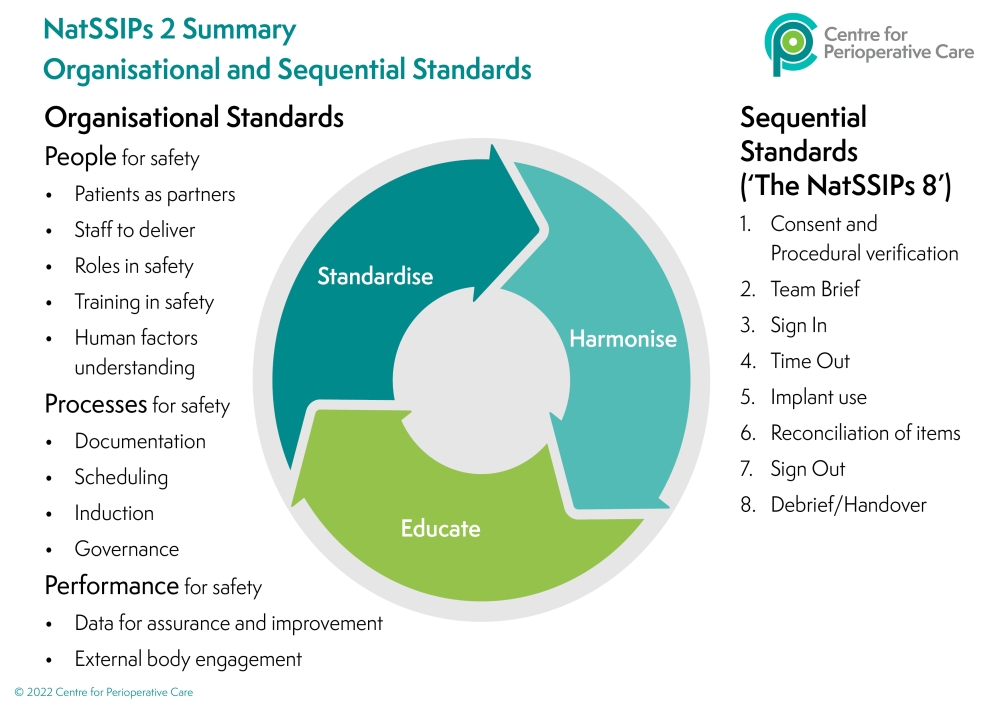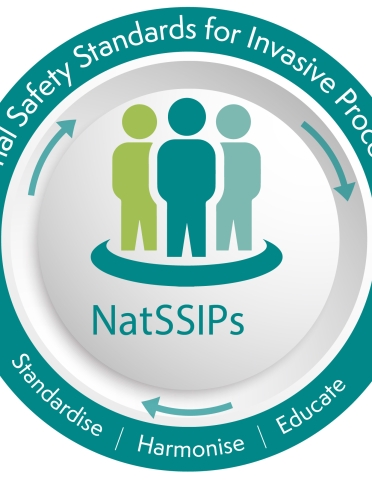The National Safety Standards for Invasive Procedures (NatSSIPs)
The original National Safety Standards for Invasive Procedures (NatSSIPs) were published in 2015. Our understanding of how to deliver safe care in in a complex and pressurised system is evolving. These revised standards (NatSSIPs2) are intended to share the learning and best practice to support multidisciplinary teams and organisations to deliver safer care.
NatSSIPs2 consists of two inter-related sets of standards:
- The organisational standards are clear expectations of what Trusts and external bodies should do to support teams to deliver safe invasive care.
- The sequential standards are the procedural steps that should be taken where appropriate by individuals and teams, for every patient undergoing an invasive procedure[1].
The NatSSIPs2 have evolved to have less emphasis on tick boxes or rare ‘Never Events’ and now include cautions, priorities and a clear concept of proportionate checks based on risk. We recognise that ‘teams’ change or may be newly formed on the day of a procedure, and therefore require clear processes. NatSSIPs2 should form the basis of improvement work, inspections and curricula.
Key principles in NatSSIPs2 include:
- The concept that NatSSIPs2 will help achieve of the triple goals of improved patient safety, better team-working and enhanced efficiency.
- The categorisation of invasive procedures into major or minor procedures, each requiring different checks which are proportionate to the risk of harm.
- The benefit of ‘Standardisation, Harmonisation, and Education’ across invasive specialty processes.
- The need to consider human factors with systems thinking, culture, psychological safety and team-work to underpin NatSSIPs2 implementation.
- An update of the WHO Five steps to safer surgery of Team Brief, Sign In, Time Out, Sign Out and Handover/Debrief to include three more steps to make the Sequential Standards (Steps): Consent and Procedural verification; Safe use of implants; and Reconciliation of items (to prevent retained foreign objects). ‘The NatSSIPs Eight’ should be in place for every relevant patient.
- That checks performed by an engaged team enable communication and save misunderstandings, reduce risk, provide clarity and set expectations
- The central role of the patient as a participant in safety checks.
- The need for a learning safety system supported by insight, involvement and improvement.
- A structure of People, Processes and Performance within the organisational standards
- The requirement for adequately resourced organisational leadership and support for safety.
The NatSSIPs2 have been written by practising clinicians, from across the four UK nations, across disciplines, professions and organisations, with patient and organisational input and published by the Centre for Perioperative Care. They incorporate safety science and learning from all UK nations’ patient safety strategies and major reports and investigations.

Every Trust board should ensure that they have:
- Adequately resourced, clinically-practicing senior and specialty-level leadership to enable sustained implementation of NatSSIPs2 across every part of the organisation.
- Sufficient time and resource for multidisciplinary team training.
- Sufficient skilled and knowledgeable teams to deliver invasive care safely.
- Appropriate induction for new staff and agency staff.
- Governance processes for NatSSIPs2 that are focussed on improvement.
For external organisations that inspect, commission, examine, educate and support;
- Inclusion of NatSSIPs2 in training and assessment
- Use of NatSSIPs2 as a framework for evaluation of services
- Use of NatSSIPs2 in policy, reports and communications
The Sequential Standards or Steps are, as they suggest, performed in a sequence for every patient in their invasive procedure pathway. They form the basis of an ‘enhanced local standard’ WHO Checklist or specialty specific checklists in some settings. Successful, sustained implementation of the Sequential Steps will only occur in the context of full engagement with Organisational Standards.
Chapters
Resources
To access the podcast, please scroll down to the bottom of the NatSSIPs webpage
To listen to our NatSSIPs webinar here
We want to hear from you on what you think of NATSSIPs 2




